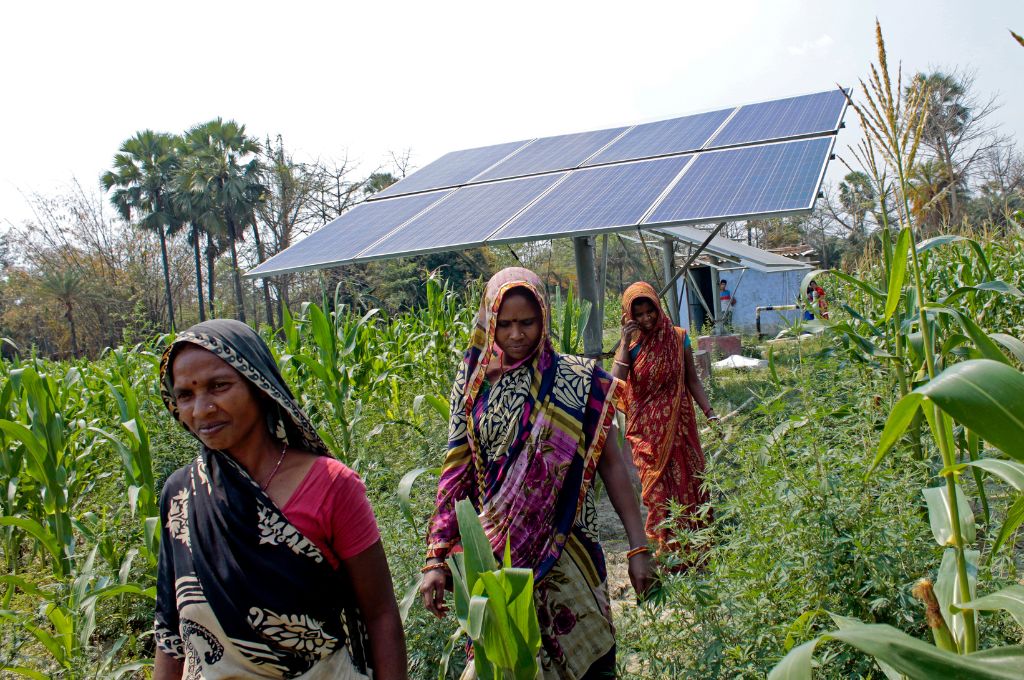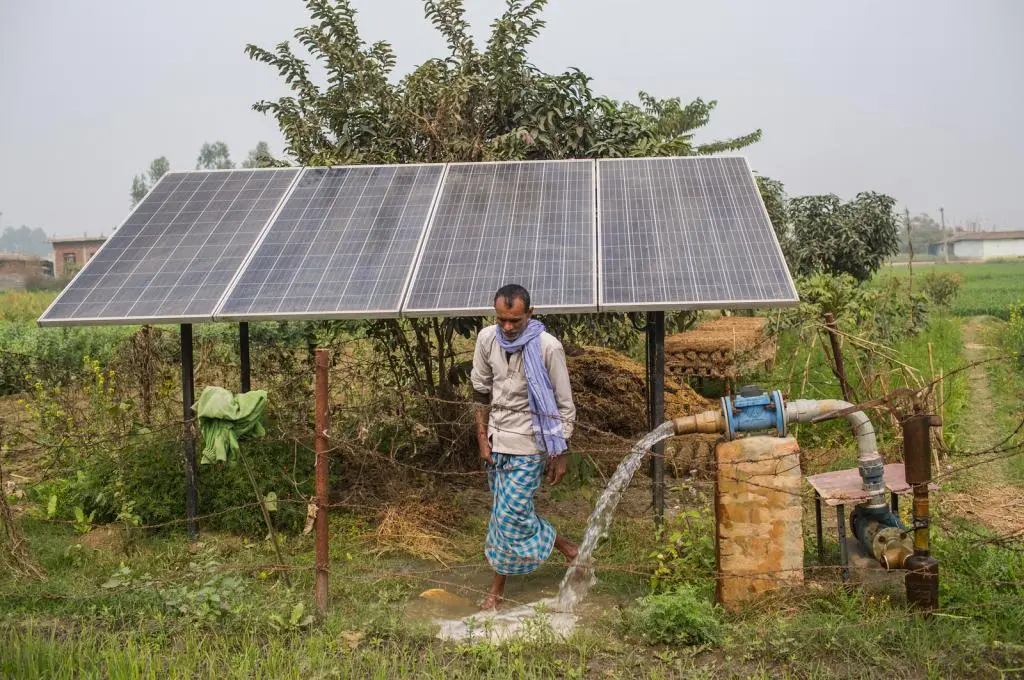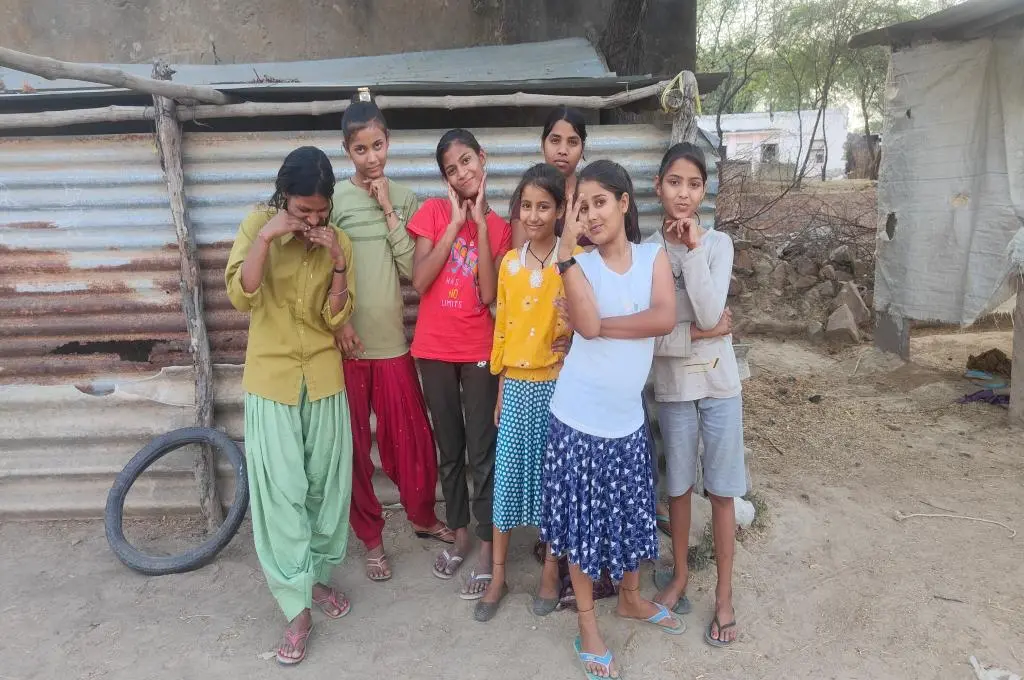Land in India is highly coveted, and therefore, highly contested. A limited resource, land must make room for an ever-growing population that depends on it for agriculture, infrastructure, industry, habitation, conservation—and, increasingly, for energy.
By 2030, India’s peak power demand, which is 243 GW at present, is estimated to increase to 366 GW. The government intends to more than double the existing power capacity to meet this demand and increase it to 900 GW from the current 427 GW. This necessitates more energy infrastructure. A substantial portion of this will comprise renewable energy (RE) infrastructure, which is expected to account for 65 percent of the country’s installed energy capacity by the end of this decade.
Different non-fossil fuel energy sources—wind, hydro, nuclear, and solar—have varying land use needs throughout their life cycles, from supply chain and operations to waste disposal. A report by the Institute for Energy Economics and Financial Analysis estimates that achieving India’s net-zero target may require 50,000–75,000 sq km of land for solar and 1,500–2,000 sq km for wind infrastructure (through direct impact) by 2050. Solar alone is likely to take up approximately 2 percent of India’s surface area.
Since 2014, the government has sanctioned 50 solar parks in 12 states, with an aggregate capacity of approximately 37.5 GW. More are to be commissioned to meet our growing energy needs.
Where will the land for these projects come from?
The past guides the present
In the 1990s, when the solar units and windmills currently in use were installed, land was not as scarce a commodity it is today. And so, many in possession of large landholdings sold 30–40 percent of their land and continued to farm on what was left of it. The compensation was generally 30 percent above the market value, plus 12 percent of the market value per annum. Governments, for their part, relaxed the rules governing the conversion of agricultural land for non-agricultural purposes.
This was how land was acquired for RE prior to the Right to Fair Compensation and Transparency in Land Acquisition, Rehabilitation and Resettlement Act, 2013—also known as the LARR Act. The legislation was introduced to regulate land use; increase compensation; safeguard the rights of landowners; and secure the interests of marginalised stakeholders, including women and landless workers.
However, certain clauses—majority consent, environmental impact assessment (EIA), and social impact assessment (SIA)—written into the act were seen as making land acquisition for industrial and infrastructural projects difficult and time-consuming. As a result, the NITI Aayog, India’s central planning agency, recommended that state governments make their own amendments to the act to meet local development priorities.
Land acquisition is a concurrent list subject, which means that both central and state governments have the power to enact legislation and frame acquisition rules. So several states—including Maharashtra, Jharkhand, Telangana, and Tamil Nadu—passed their own acts that eventually permitted sectors like RE to sidestep SIAs and EIAs when acquiring land, as they produce an essential utility like electricity.
These circumventions, however, have led to a host of negative social and environmental impacts, including loss of livelihood, biodiversity, dispossession, malnutrition, and increased poverty, particularly for the landless. Such effects have been observed a decade or so after the operationalisation of projects; the long-term consequences are yet to reveal themselves.

The price of land use change
People depend on land for their livelihood and sustenance, whether they are tenant farmers growing paddy or desert pastoralists herding goats. And so, any attempt to obtain land for RE has to consider not only who lives on it, but off it, for even those without ownership rights rely on it.
While the social and economic impacts of land use change are experienced differently by different stakeholders, it is marginalised groups who are most affected. The impacts on them are immediate and everyday: women may have to travel twice as far for water when streams and ponds are enclosed within project fences. They also extend to the distant and indirect: those without land tenure are denied equitable compensation or access to benefits and grievance redressal systems for themselves and their families.
There is also the far-off fallout of RE projects to consider, with anticipated changes to project sites and peripheral areas.
There is also the ecological impact. Land use for RE is likely to put a strain on a variety of ecosystems. For instance, wastelands, which cover large stretches of land in central and western India, have the highest densities and diversity of large mammals. The Khavda RE Project, which is being set up in the Rann of Kachchh—a vast area of salt marshes in the Thar Desert—will disturb local soil composition, release stored carbon into the atmosphere, create hazards for wildlife, and restrict areas used by pastoralists for grazing or migration.
There is also the far-off fallout of RE projects to consider, with anticipated changes to project sites and peripheral areas. As an organisation that works to support land rights for the global poor, Landesa has been monitoring the social and economic mechanisms for land use for RE in India. We visit and revisit project sites to understand their evolving impact on local communities and the environment, and these field trips have revealed both observed and perceived changes.
For instance, when we visited the Pavagada Ultra Mega Solar Park in 2021, the locals told us they were concerned about the fertility of the soil after years of it being denied direct sunlight. They were also worried that groundwater levels would decline, because they believed that ground-mounted solar panels prevent rainwater from seeping into the earth. While there’s little evidence to support this, there are studies that point to the dependence on local water sources for the maintenance of solar panels. According to some estimates, solar farms in India need 7,000–20,000 litres per MW every time they are washed, which can burden water-scarce regions. For a plant the size of Pavagada, which is already located in a drought-prone region, this translates to 14,000 to 40,000 kilolitres of water per wash.
Concerns like these, along with reports of rights abuses and partisan land deals that prioritise private gains over community benefits, risk jeopardising current and future RE projects, making land procurement more challenging and the biggest bottleneck to development.
Using land optimally
Large solar installations need thousands of acres of land at a stretch. The Bhadla Solar Park in Rajasthan covers more than 14,000 acres, and Karnataka’s Pavagada Park is spread across more than 13,000 acres. Even if RE developers prioritise barren and converted land, they will inevitably need access to adjacent agricultural and ecologically sensitive land like commons, for large projects. Additionally, even government-owned barren land may be informally occupied or used by people who lack tenure security.
Can RE projects be installed there in a way that preserves, and even enhances, the livelihood and well-being of local communities and mitigates environmental damage? A responsible RE business model—one that centres social equity, justice, and ecological health in the production of renewable energy—can achieve this.
There are several ways to accomplish these goals, beginning with responsible site selection, which can minimise the negative impacts on the environment and communities, and by framing negotiations around equity and justice. Responsible siting prioritises low-value, non-agricultural, repurposed government wasteland, or converted land for RE projects, and only when such land is unavailable or inadequate should agricultural land be utilised.
In either case, here are some of the paths to land use that responsible RE would entail.
Multiple land use
In the mid 1990s, wind energy developers in Karnataka’s Gadag district pioneered the system of multiple land use with shared rights. In December 2020, Landesa visited Gadag, where windmills were set up by companies such as Bhoruka, Suzlon, GreenSol, and ENERCON. Landowners who had sold their land at a negotiated price informed us that 1 acre was procured for each turbine. But except for approximately 0.1 acre beneath each turbine, farmers were allowed to continue cultivating the rest of the land. This gesture created tremendous goodwill among the farmers, who earned one-time revenue from the sale, alongside an ongoing income from their agricultural produce.
Earlier, multiple land use could not be considered for solar farms, extending as they did over vast tracts with solar panels installed close to the ground. However, agrivoltaic systems have now made this a possibility in the solar sector too.
Research on the long-term impacts on soil and water on and around RE plants must progress in tandem
These systems allow food and energy production to take place simultaneously by making it possible to plant crops, raise livestock, or farm fish under panels raised several feet off the ground. As with the wind farms, farmers here too can earn from agriculture and the land lease. Moreover, these models allow for landless labourers to continue to earn off the land.
However, agrivoltaics are in their early stages in India and their potential benefits and impacts are still being tested out.
The model can also be adopted in hybrid power systems that consist of wind and solar installations. Whatever the model adopted, RE projects must create new opportunities for communities to pursue adaptive farming.
Even as multi-use models are being explored, research on the long-term impacts on soil and water on and around RE plants must progress in tandem. These studies will help developers better prepare to mitigate potential losses and enable communities to adapt to the landscape they will eventually reclaim when the lease ends.
Licence to lease
Leasing has become the preferred mode of securing land. After the mid 2010s, RE development shifted from a capex (capital expenditure) to an opex (operational expenditure) model, leading to a preference for leasing over purchasing. The benefits of the opex model include not just reduced investment for companies, but also the assurance that landholders will recover their assets when the lease ends.
The larger the assets or landholdings—as they typically are in central and western India—the easier the negotiations. The more fragmented the land—as it is in Bihar, West Bengal, and Uttar Pradesh—the more challenging it becomes, because you may now have to negotiate with 350 landowners rather than with 10.
There are models we can learn from. In Pavagada, farmers who leased their land to the Karnataka Solar Power Development Corporation Limited (KSPDCL) were promised a 5 percent increase on the compensation every two years. After 10 years, the compensation is to be reviewed jointly with the community. However, if a decade later the value of the land far exceeds the agreed compensation, people are likely to be disgruntled.
Developers need to anticipate these scenarios and find ways to build and maintain trust with the community so that their relationship with the project is a positive one. This requires a regular and fair appraisal of evolving market rates and compensating the community accordingly. Factors like schools, health centres, and paved roads built by the developer for the community also influence these negotiations.
Ancillary factors
There are other, associated elements that determine the success of land access for RE. Some of them include:
1. Updated land records
Land bank data is maintained by states. However, records of land use and land cover (LULC) are often outdated. The Digital India Land Records Modernization Programme (DILRMP), which is an online repository of spatial and textual data of the land, can be a vital tool in addressing this problem. Making data on land availability, ownership, legal status, and suitability immediately and easily accessible can help speed up the process of land acquisition and avoid costs associated with delays.
An updated land inventory is critical for efficient land use planning. This planning needs closer coordination between different tiers and departments of the government, such as the revenue department and the National Remote Sensing Centre. This will produce a clear picture on how much uncultivable wasteland, degraded land, or land ceiling surplus is available at the district level and reveal what can be converted for RE use with the least impact to people and the environment.
Once the land is identified, the local district collector can have the records updated, and the land reclassified within a month. It also necessitates a strong collaboration between the developer, government, and community, so that trust is established between them, and the acquisition can proceed smoothly.
However, the government should avoid getting into the business of negotiations and leave it to developers to communicate directly with local communities when private land is at stake.
2. Inclusive negotiations
It falls on the developer to establish a just, equitable, and rights-based framework for land access, whether the land is to be leased or purchased through negotiated settlements. External mediators or facilitators hired by developers to negotiate with communities should closely read the socio-economic landscape; understand attitudes around livelihoods, the local ecology, and cultural pride; grasp the relationship people share with the land; and truthfully convey their observations to the company.
But it is the responsibility of the company to set frameworks for accountability. There have been cases where unscrupulous facilitators have purchased land in a region earmarked for a project, only to sell it at an exorbitant price to the company later. Actions like this goad local landowners to also want to sell at similar rates, thereby undermining the benefits of the lease model and inflating the cost of the project.
It is therefore vital for companies to closely monitor these negotiations, ensure transparency, and intervene when needed to engage directly with landowners. This will help developers frame terms that will meet with least resistance and enable them to create opportunities to convert communities from ‘beneficiaries’ to empowered stakeholders.
Conversations should take place with community leaders as well as gender, caste, and class minorities. Additionally, local government institutions should be included to ensure that decisions are not taken unilaterally by those who hold power within the community.
RE developers should pay particular attention to the rights of the marginalised.
At some solar sites, for example, women have found themselves denied an agricultural income besides being saddled with the additional responsibility of single-handedly caring for their families. This was because their husbands migrated to cities for work, having found none at the project site.
RE developers therefore need to anticipate the future, far-reaching impacts of their actions—and the people affected by them—when devising and financing rehabilitation strategies. And they should pay particular attention to the rights of the marginalised. Two years ago, an agency entrusted with conducting SIAs at a particular project site failed to consider the potential impacts on marginalised groups in the community. The SIA report they submitted took care of small and large landholders but left the landless out.
Another point to consider is this: negotiations around land access are typically concerned with the interests of the individuals—both landowners and the landless—directly affected by the loss of land. However, attention must also be paid to those in the community whose land was left out of the acquisition, for envy of their neighbours’ gains may stir up disaffection that could forestall the project. Attentive to these potential problems, developers should make sure to distribute benefits to the community at large.
The government should also play its role and ensure that equity is delivered in all RE land procurement deals—with shared benefits for everyone—by restoring the SIAs and EIAs mandated by the LARR Act. Bypassing these assessments will serve neither the community nor the developer or even the government in the long run. They lead to conflicts that have a direct bearing on energy security. The greater the conflict and the delay in operationalisation, the higher the cost of energy; this also reduces the number of people who can afford RE.
3. Positive messaging
The discussion on scaling the RE sector often overlooks an important stakeholder: the media. Public perception of RE development depends largely on how it is portrayed in the media. Negative news coverage—that which focuses on rights denied and livelihoods lost—will colour people’s opinion and may even deter landholders from leasing their land to developers.
It’s important for the developer to have a well thought out strategy on working with the media to disseminate messages that reinforce the long-term benefits of clean energy and energy security; the company’s efforts to centre the community in its plans should be highlighted as well. Naturally, this is contingent on community-building measures that are actually being implemented. Positive messaging will also win the confidence of the affected communities and reassure them that they are bona fide stakeholders in the process.
Much has been said about the Pavagada model. When we visited the site in 2021, we discovered that although the community had not yet received the free electricity promised, they had access to other facilities. More schools and colleges had opened in the area. This addressed the problem of the local youth having to travel 45 km to attend college. The local government was also more involved in the development of the region, with better water supply, road connectivity, health facilities, etc.
No benefits can arrive overnight; their delivery needs long-term planning. And these plans need to be reviewed every five to 10 years keeping in mind benefits for the next generation. The media can help amplify these ideas.
4. Room for civil society
Companies need to bring more civil society organisations (CSOs) into RE negotiations as they are well placed to coordinate between the government, industry, and community. As organisations that work closely at the grassroots, CSOs are trusted by the community. This places them in an advantageous position to rally for better terms on their behalf, and to mitigate potential conflict that may emerge from a project. Civil society can thus play an instrumental role in developing a community-centred, participatory model for scaling RE.
The stability and success of an RE installation depends on genuine efforts to take people along.
Developers should identify credible CSOs working in the field and use their support to reach out to communities to convey both the benefits the locals stand to receive from an equitable deal and the need for non-polluting, climate-friendly energy sources. There is a delicate balance between securing the rights of people, preserving the environment, and building out a carbon-free energy system. But it’s not impossible to achieve.
Land will continue to anchor renewables in the future. But what land, how much, how it is utilised, and whom and what it is impacting will determine the social and economic viability of these projects. The stability and success of an RE installation depends on genuine efforts to take people along.
Ultimately, no energy source is completely free of liability. There is always a trade-off between what is gained and what is lost. But in the quick march to climate-improvement, if people and the environment are given the short end of the stick, the win will be pyrrhic.
—






